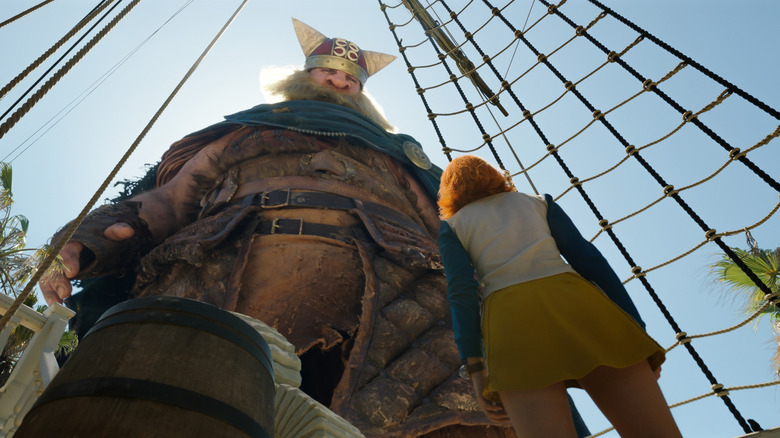Netflix's One Piece Season 3 Is Confirmed, But How Long Will The Series Last?
The first proper trailer for the second season of the "One Piece" live-action show is finally here, and we got our first look at some highly anticipated locations and characters, from Smoker and Vivi to Brogy and Nico Robin. So far, this show already has a rather good track record when it comes to casting, and the trailer does not disappoint.
The show adapts Eiichiro Oda's legendary manga, which was already adapted in a still-ongoing anime that's equally legendary, and follows Monkey D. Luffy (Iñaki Godoy), a boy who dreams of becoming King of the Pirates and finding the legendary treasure known as the One Piece. The show is full of people with extraordinary abilities brought upon by Devil Fruits, as well as all sorts of creatures and wildly inventive ships. Season 2 is expected to cover the Loguetown, Reverse Mountain, Whiskey Peak, Little Garden, and Drum Island arcs, which raise the stakes and introduce even more wild ideas and creatures.
Arguably, the bigger news of the weekend was not the release of the trailer, but rather the announcement at the very end of it that "One Piece" will also get a third season in the near future. This is fantastic news for fans, of course, especially because it means the show will get to adapt one of the best story arcs in Alabasta. That being said, it does raise one very important question: How long can the show realistically last?
Can One Piece ever be a complete adaptation?
The problem with adapting "One Piece" into live-action is that the story is overwhelmingly long. There is arguably no single fictional story with as big a scope or as long a narrative as Oda's "One Piece," as it is currently at 1156 chapters and counting, of which the first season of the live-action adaptation only covered about 96. Even without today's extremely long wait times between new seasons of high-profile TV shows, there is little chance the live-action "One Piece" could take less than 15 years to get to where the manga is at now — which is still not even the final arc of the story! Given that the main cast is in their late 20s to early 30s (with the exception of Godoy, who plays Luffy and is 21), it's unlikely Netflix will continue making the show with the cast approaching 50 but still playing teenagers.
This is not even accounting for the fact that "One Piece" only gets weirder and bigger from here. Even if the trailer for season 2 does a good job of translating some of the more fantastical elements, like the giants or the whale Laboon, we are still only in the early days of the story. There is still a long way to go before we start regularly meeting mermaids, cyborgs, zombies, giant zombies, or the extreme number of characters who are 20 feet tall for no reason. And we haven't even mentioned the absurd power scaling that happens as the story progresses, with characters being able to turn into giant dragons and all sorts of creatures. Generally, the story not only gets bigger in terms of scope (can you even imagine Marineford or Wano being adapted in live-action without Netflix going bankrupt?) but also just the tone of the story gets more and more absurd as the scale increases. This is a cartoonish, wacky, and silly world, and even if season 1 of the live-action show did a wonderful job capturing that, it gets harder once the cartoonish elements extend not just to costume choices, but the very fabric of the story's reality.
After all, the biggest power-up in the story is essentially Luffy turning into Bugs Bunny, which works wonderfully in animation, but can it be done in live-action?
When should One Piece stop?
If "One Piece" is destined to stop before it reaches the end of the story, it's worth speculating where it could (or should) end. Arguably, the most important thing is that the show needs to find a place that can give it the most satisfying stopping point possible, while still being early enough in the narrative that getting there doesn't become prohibitively expensive.
That means the absolute latest the show could theoretically finish is with Marineford, as it comes right before a timeskip where the story all but stops for two years in-universe. The problem with this is that Marineford is both a hugely expensive and expansive story arc with a battle bigger than any in the "Lord of the Rings" trilogy. The other problem is that Marineford ends on a rather sour note, a moment of defeat for our characters — so not exactly the point where you want to end the show.
If not that, then the next obvious place to stop the story is Water 7 and Enies Lobby. For me, this would be the best case scenario. Enies Lobby is one of the best story arcs in the entire series: It's the moment Nico Robin fully becomes a member of the Straw Hats, the moment Luffy goes from being a small-time but still mighty pirate to grabbing the attention of the entire world, and the moment "One Piece" becomes about more than just a group of friends going on their own little adventure. Stopping here means the audience is left to wonder and imagine just where the story goes next (a perfect selling point for the anime and manga) while still being a rather satisfactory end to the story of the Straw Hats (at least the ones who joined up to that point) coming together as a group.
Given that season 3 is all but guaranteed to cover Alabasta, it will arguably have to cover some of the next storyline because eight episodes on a single arc is simply too long (especially for the pace the show has taken so far). The most likely scenario is that season 3 will get us up to the very start of Skypeia or shortly before it, while season 4 gets us to Water 7 and where everything starts to go wrong for the Straw Hats. This gives the fifth season the chance to conclude the story in a grandiose way. We'll have to wait and see, but in the meantime, season 3 of "One Piece" drops on Netflix in 2026.

